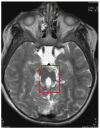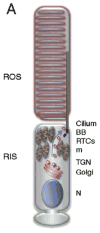Nephronophthisis and related syndromes
- PMID: 25635582
- PMCID: PMC4422489
- DOI: 10.1097/MOP.0000000000000194
Nephronophthisis and related syndromes
Abstract
Purpose of review: Nephronophthisis (NPHP) is an autosomal recessive cystic kidney disease and is one of the most common genetic disorders causing end-stage renal disease (ESRD) in children and adolescents. NPHP is a genetically heterogenous disorder with 20 identified genes. NPHP occurs as an isolated kidney disease, but approximately 15% of NPHP patients have additional extrarenal symptoms affecting other organs [e.g. eyes, liver, bones and central nervous system (CNS)]. The pleiotropy in NPHP is explained by the finding that almost all NPHP gene products share expression in primary cilia, a sensory organelle present in most mammalian cells. If extrarenal symptoms are present in addition to NPHP, these disorders are classified as NPHP-related ciliopathies (NPHP-RC). This review provides an update about recent advances in the field of NPHP-RC.
Recent findings: The identification of novel disease-causing genes has improved our understanding of the pathomechanisms contributing to NPHP-RC. Multiple interactions between different NPHP-RC gene products have been published and outline the interconnectivity of the affected proteins and shared pathways.
Summary: The significance of recently identified genes for NPHP-RC is discussed and the complex role and interaction of NPHP proteins in ciliary function and cellular signalling pathways is highlighted.
Conflict of interest statement
None
Figures






Similar articles
-
Defining the optimum strategy for identifying adults and children with coeliac disease: systematic review and economic modelling.Health Technol Assess. 2022 Oct;26(44):1-310. doi: 10.3310/ZUCE8371. Health Technol Assess. 2022. PMID: 36321689 Free PMC article.
-
Depressing time: Waiting, melancholia, and the psychoanalytic practice of care.In: Kirtsoglou E, Simpson B, editors. The Time of Anthropology: Studies of Contemporary Chronopolitics. Abingdon: Routledge; 2020. Chapter 5. In: Kirtsoglou E, Simpson B, editors. The Time of Anthropology: Studies of Contemporary Chronopolitics. Abingdon: Routledge; 2020. Chapter 5. PMID: 36137063 Free Books & Documents. Review.
-
The effectiveness of school-based family asthma educational programs on the quality of life and number of asthma exacerbations of children aged five to 18 years diagnosed with asthma: a systematic review protocol.JBI Database System Rev Implement Rep. 2015 Oct;13(10):69-81. doi: 10.11124/jbisrir-2015-2335. JBI Database System Rev Implement Rep. 2015. PMID: 26571284
-
Qualitative evidence synthesis informing our understanding of people's perceptions and experiences of targeted digital communication.Cochrane Database Syst Rev. 2019 Oct 23;10(10):ED000141. doi: 10.1002/14651858.ED000141. Cochrane Database Syst Rev. 2019. PMID: 31643081 Free PMC article.
-
Conservative, physical and surgical interventions for managing faecal incontinence and constipation in adults with central neurological diseases.Cochrane Database Syst Rev. 2024 Oct 29;10(10):CD002115. doi: 10.1002/14651858.CD002115.pub6. Cochrane Database Syst Rev. 2024. PMID: 39470206
Cited by
-
Refining Kidney Survival in 383 Genetically Characterized Patients With Nephronophthisis.Kidney Int Rep. 2022 Jun 16;7(9):2016-2028. doi: 10.1016/j.ekir.2022.05.035. eCollection 2022 Sep. Kidney Int Rep. 2022. PMID: 36090483 Free PMC article.
-
Whole Exome Sequencing Reveals a XPNPEP3 Novel Mutation Causing Nephronophthisis in a Pediatric Patient.Iran Biomed J. 2020 Nov;24(6):405-8. doi: 10.29252/ibj.24.6.400. Epub 2020 May 31. Iran Biomed J. 2020. PMID: 32660933 Free PMC article.
-
Immunofluorescence analyses of respiratory epithelial cells aid the diagnosis of nephronophthisis.Pediatr Nephrol. 2024 Dec;39(12):3471-3483. doi: 10.1007/s00467-024-06443-0. Epub 2024 Aug 5. Pediatr Nephrol. 2024. PMID: 39098869 Free PMC article.
-
Two Chinese nephronophthisis pedigrees harbored a compound heterozygous deletion with a point mutation in NPHP1.Int J Mol Epidemiol Genet. 2019 Aug 15;10(4):53-58. eCollection 2019. Int J Mol Epidemiol Genet. 2019. PMID: 31523374 Free PMC article.
-
Renal-Hepatic-Pancreatic Dysplasia: An Ultra-Rare Ciliopathy with a Novel NPHP3 Genotype.J Pediatr Genet. 2020 Jun;9(2):101-103. doi: 10.1055/s-0039-1696974. Epub 2019 Sep 12. J Pediatr Genet. 2020. PMID: 32341812 Free PMC article.
References
Publication types
MeSH terms
Substances
Supplementary concepts
Grants and funding
LinkOut - more resources
Full Text Sources
Medical
Research Materials

